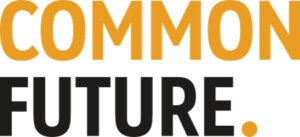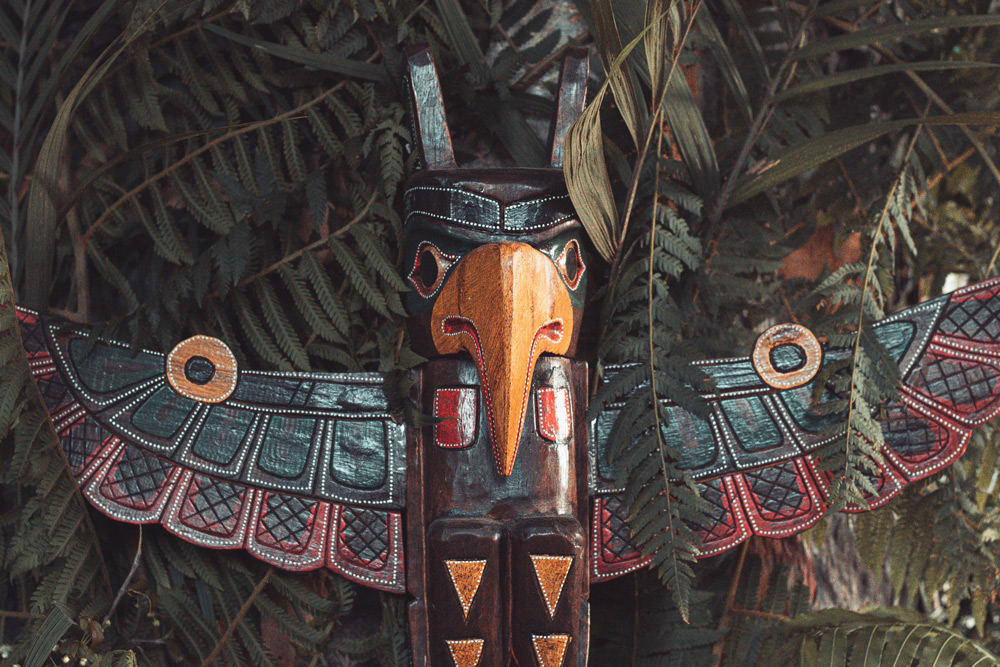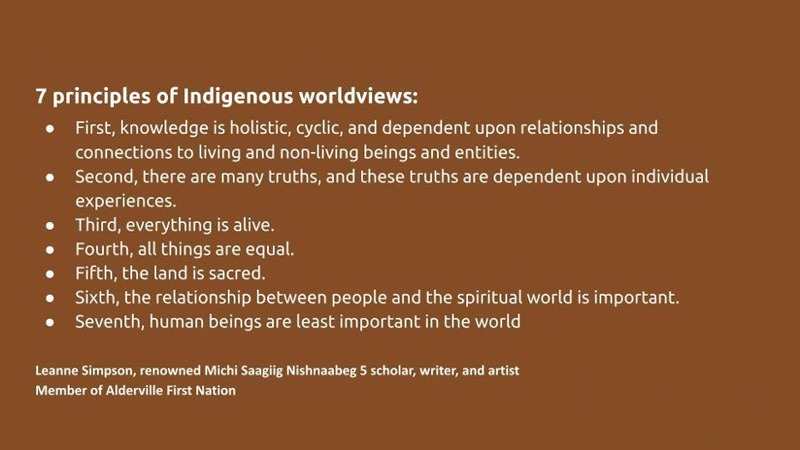

With this article, we conclude our series—Narratives to Build Collective Economic Power—which NPQ is publishing in partnership with the national racial and economic justice nonprofit, Common Future. In this series, the authors write about their economic justice work and how, in their work, they challenge conventional narratives and offer new ways of thinking about who can be owners in the economy and what community economic development means.
In my “day job,” I am a systems designer consultant. The firm I helped found, Roanhorse Consulting, employs six people, soon to be eight. I am also a co-founder of Native Women Lead, a nonprofit that supports Native women business owners across the country. In my work, I didn’t purposefully set out to build “collective economic power,” yet that phrase describes a lot of the work that my colleagues and I do. Why?
It’s all about my own cultural background and the community I serve. If you grow up Diné (Navajo), collective wellbeing is core to your value system and permeates how you see yourself as five-fingered people, which is how we relate to the world around us through our clanship system. For example, I recently attended a conference in Vancouver. There were other Navajo people in the room of over 1,600 attendees, and when they introduced themselves, I was able to connect with another Navajo woman who had been living in Manitoba for the last 20 years as my granddaughter through our clans. This expression of Ké is a reminder that we are all connected, that no matter how far we go, as Navajo people, we can always find ourselves through this system as part of the broader collective of people. We share an unspoken sense of commonality and responsibility. This “collective” mindset is so integral to everything we do, and it upends the default, stodgy worldview of individualized economic power, which doesn’t actually represent most of us.
So often, in our capitalist system, we are told that our mutuality is not productive or scalable and should therefore be abandoned. It is exhausting how destructive capitalism and white supremacy have been on Indigenous people worldwide and how a singular western worldview has dominated our global economic paradigm. So much so that, even amid a climate crisis, we still evaluate financial risks based on the impact such risks have on the company’s bottom line versus the risks to the Earth we live on.
In the wide spectrum of health disparities in the US (and globally), we see the results of a siloed economic perspective that does not acknowledge the cyclical relationship we have to all living beings and the environment around us. In short, the system is broken. If we do not acknowledge that, then we’ll never be able to have a real conversation about economic justice or imagine forward a different economic paradigm. And for us to get there, we need a cultural shift across the board; we need a collective admission that white supremacy, colonization, patriarchy, and capitalism are the root causes for where we are today.
What Does an Indigenous Worldview Look Like?
Because of the dissonance that happens when we speak with non-Native partners, we’ve started using the slide below at the beginning of conversations with people who are interested in partnering with us. The people at these organizations tend to be folks who are privileged, have capital, and want to do something good. However, they have a very different worldview than ours. I tell them that in order to have a meaningful conversation, we need them to start from a new place. To bring them to our perspective, we present this slide and ask them to imagine what it would look like if we were to ground ourselves in this worldview when tackling the questions they’re asking.

One critical point this slide makes is that we must acknowledge that the world’s resources are finite. We are connected to all living beings; therefore, all humans have a responsibility to be stewards of our living world. We believe that building real, lasting, sustainable economic power means acknowledging that there is a multitude of worldviews, all of which are valid. If we do that, then we can build new frameworks, measurements, and outcomes that actually meet people where they are with what they need, instead of building for only a few. This requires acknowledging there are many ways to tackle a problem.
Our model acknowledges that economics affects the whole person, their families, and their communities—it is not separate from other things happening in a person’s life such as health, safety, and education. In other words, we approach the issue from a place of “centering those who are most impacted and investing in their solutions.”
These days, when I speak with potential partners and organizations that are non-Native, it’s not always clear to folks what we mean when we say to “lift up Indigenous worldviews.” One example in the Southwest is bringing back waffle gardens, a sustainable farming technique used by Pueblo peoples for thousands of years. This technique is designed for more arid climates where water must be properly sequestered and soak into the ground efficiently. During the pandemic, we saw many Indigenous people return to the land as they saw food supply chains disappear in their communities.
In January 2022, the Food Research and Action Center released the Reimagining Hunger Responses in the Time of Crisis report, sharing that 48 percent of respondents experienced food insecurity; however, through the lockdowns and scarcity, people started their own gardens, and folks began to find locally available meat and other produce. There already was a movement to return to ancestral eating and growing by fostering Indigenous agriculture (or “regenerative agriculture”). However, now the urgency to achieve self-sufficiency by investing in our tribes’ local food systems is the charge forward. For many, eating ancestral food means that tribes can practice their own communities’ form of eating and catching/hunting, and we’ve found that eating this way leads to reduced heart disease and diabetes, and slows down desertification. It also encourages a local food system that is not reliant on fragile outside food systems that can be easily broken.
Sign up for our free newsletters
Subscribe to NPQ's newsletters to have our top stories delivered directly to your inbox.
By signing up, you agree to our privacy policy and terms of use, and to receive messages from NPQ and our partners.
Standing on the Shoulders of Matriarchs
I come from a matrilineal system, which means that all property and wealth pass through women. In Diné communities, women have always been seen as leaders. Indeed, female leadership appears in our creation stories, starting with Changing Woman. However, through colonization and patriarchy, women have been pushed out of the circle of leadership. Our work now is to bring women back into it. At Native Women Lead, we always start through an asset-based framing of what it means to bring women back into the circle. We share that in 2017, American Indian and Alaskan Native women founders in the United States generated $11 billion dollars in revenue without any meaningful access to resources from people or organizations that understand their journey. Our women are starting companies two times faster than our white female counterparts while making 60 cents to the dollar. Imagine what could happen if we just tried to build the system the right way for them! In my role as a Native woman leader, I’m standing on the shoulders of these matriarchs who taught me and those before me. It is time to center them and invest in them directly.
It’s important to note that this is not just “our” model. We are building something that Indigenous people have always known and which has always been present in the collective economies of Native communities. The work we do around “reframing economics” is work to breathe life back into “old” ways.
Collective economies rely on thousands of years of ancestral knowledge and wisdom that we’re drawing from. Indigenous leaders and critical theorists have been working towards such economies for a long time. Just read Carol Anne Hilton’s book, Indigenomics: Taking a Seat at the Economic Table, where she outlines some characteristics of an Indigenous economy:
- “A sense of responsibility to place and time”
- “Multigenerational thinking (7 generations ahead)”
- “Restorative and regenerative in nature—that is, of lands, resource management, conservation, and long-term conservation of resources”
- “‘Only take what is needed’ approach”
- “Measuring wealth through relationships and community across time”
Barriers to Adopting New Approaches
Though we know that our approaches work in our communities, the idea that economic systems are written in stone and that the “market is always right” remains pervasive. But the market is mutable and young, which means it can change. We can change it.
And, as we saw during the pandemic, systems did change. Paycheck Protection Program (PPP) loans shifted the way institutional banks and financial intermediaries underwrote loans to small businesses, and we saw the agility with which small community development financial institutions (CDFIs) were able to move capital to BIPOC entrepreneurs in ways private banks could not. While we know how important it is to have a strong banking relationship to access capital, we also know that if you can’t physically access a bank in your community and are reliant on automated banking systems, you will continue to be unbanked and underinvested in. The opportunity for us to build and invest in our local banking infrastructures and financial intermediaries—to own our own financial futures and underwrite a future that looks like us—is another charge forward for our communities.
Telling New Stories, Restoring the Circle
So, we need to acknowledge and overcome to accessing financing, and we need these shifts to happen in our culture in order to build a more equitable economy. That’s why the things we’re working on now—character-based lending, equity financing, and greater representation of Native women business leaders—are inputs to an output that results in a transformative outcome. They’re the things we have to throw into this machine so we can understand it. But ultimately the outcome we want is a just place where all people live a life of dignity, agency, and self-determination.
If that is the outcome, then these inputs—creating new Indigenous-led funds, cultivating more Indigenous fund and money managers, spending endowments down, acknowledging that the growth-without-costs mindset that undergirds our investment portfolios is the problem and that we need to limit growth and put the risk on the companies and not the Earth—are all critical to the process of undoing systemic structural racism and economic exclusion. Only by implementing this kind of multifaceted approach can we ensure the well-being of our people and planet.
Writing about Indigenous economics in NPQ last year, Ruth Miller, Meda Dewitt, and Margi Dashevsky noted, “Policy must remember forward and be ambitious in its mission to restore ecosystems, food systems, and practices of reciprocity.” At my consulting firm and Native Women Lead, my colleagues and I have sought to develop a relationship model of lending that recognizes that existing lending norms undervalue Native capacity and overstate the risks. To date, the lending program we helped develop has lent funds to more than 200 Native women-led businesses, with less than a two-percent default rate.
Much work remains to be done. One of our key goals is to articulate models that depict the wisdom and creativity of Indigenous people on our terms. The inherent difference in all this work, when counterposed to conventional Western economics, is to reset the purpose of economics. We want the connectedness that comes from leaning on—and being able to provide for—your community. We desire the wealth that comes from health and wholeness and a sense of commonality and collective mindsets. But the ultimate goal is not endless growth—it is to be free and unapologetically Indigenous.











